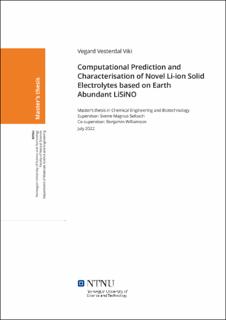| dc.contributor.advisor | Selbach, Sverre Magnus | |
| dc.contributor.advisor | Williamson, Benjamin | |
| dc.contributor.advisor | Eggestad, Kristoffer | |
| dc.contributor.author | Viki, Vegard Vesterdal | |
| dc.date.accessioned | 2022-10-26T17:19:52Z | |
| dc.date.available | 2022-10-26T17:19:52Z | |
| dc.date.issued | 2022 | |
| dc.identifier | no.ntnu:inspera:108213079:18382972 | |
| dc.identifier.uri | https://hdl.handle.net/11250/3028501 | |
| dc.description | Full text available on 2023-11-01 | |
| dc.description.abstract | "All solid-state-batterier" (ASSB) basert på faststoff elektrolytter (SSE) er en lovende løsning på de nåværende sikkerhetsproblemene som moderne batteriteknologi står ovenfor. LiSiNO-strukturen har tidligere vist seg lovende for bruk som faststoffelektrolytt basert på sitt stor båndgap og gunstige Li-ion migrasjonsveier. I denne masteroppgaven er mulighetene for å forbedre egenskapene til LiSiNO ved å lage LiSi _(1-x)Ge _xNO og LiSiNO _(1-x)S _x solide løsninger utforskes. Density functional theory (DFT) beregninger med "PBE-
sol-functional" brukes for beregne 25%, 50% og 75% substitusjoner av LiSi _(1-x)Ge _xNO og LiSiNO _(1-x)S _x. Målet med oppgaven er å analysere entalpi- og Gibbs frie energi av mixing for de to faststoffløsning systemene. I tillegg vil "density of states" og båndgap bli beregnet for å få en tilnærming av det elektrokjemiske stabilitetsvinduet til materialene. Til slutt vil Li-ion mobiliteten bli undersøkt ved hjelp av en maskinlæring "Molecular Dynamics" (ML-MD) metode for alle strukturene og "nudged elastic band" (NEB) beregninger vil beregne mulige Li-migrasjonsveier for LiSiNO _(0.75)S _(0.25).
De to faststoffløsningssystemene ble begge funnet til å ha positiv blandingsentalpi og Gibbs frie energi for mixing. Vegards lov ble også nært fulgt av de undersøkte faststoffløsningene, bortsett fra LiSiNO _(0.75)S _(0.25) som negativt avvek fra linearitet. Analysen av den elektroniske strukturen viste videre en nedgang i båndgap med økende Ge- og S-substitusjon. Faststoffløsningene presterte fortsatt gunstig sammenlignet med konkurrerende faste elektrolytter slik som LISICON, LLTO og LGPS. Den kortsiktige ML-MD analysen på 100 ps demonstrerte en forbedring i Li-ion mean square displacement(MSD) for LiSiNO ved erstatning med 25% og 50% S, men substitusjonen av Si for Ge viste ingen innvirkning på Li-ion MSD. De langsiktig ML-MD-simulering på 10 ns støttet ytterligere påliteligheten til kort sikt simuleringsresultater ved å produsere de samme trendene, men dessverre ble ingen diffusjonsregime oppnådd. NEB-analysen for LiSiNO _(0.75)S _(0.25) produserte tre Li-migrationsveier som var ekvivalente med de funnet i LiSiNO og LiSiNS. De tre migrasjonsveiene hadde migrasjonsenergibarrierer på 0.31 eV, 0.65 eV og 0.24 eV henholdsvis. Her ble migrasjonsbarrieren forbedret fra LiSiNO for første vei, men økt for vei 2 og 3. Migrasjonsbarrieren for vei 3 var imidlertid fortsatt betydelig lav. Resultatene viste dermed at LiSiNO _(1-x)S _x kan være gunstig for å produsere bedre Li-ion-migrering på bekostning av en relativt lav kostnad i båndgap, mens LiSi _(1-x)Ge _xNO faststoffløsningene bare senket båndgapet uten å tilsynelatende påvirke Li-mobiliteten. | |
| dc.description.abstract | All solid-state batteries(ASSB) based on solid-state electrolytes(SSE) are a promising solution to contemporary battery technology's current safety issues. The LiSiNO structure has previously shown great promise for the use as solid-state electrolyte based on its very large band gap and preferable Li-ion migration paths. In this master thesis, the possibilities of improving the properties of LiSiNO by the creation of LiSi_(1-x)Ge_(x)NO and LiSiNO_(1-x)S_(x) solid-solutions are being explored. Density functional theory(DFT) calculations with the PBEsol functional are being used to calculate 25%, 50% and 75% substitutions of LiSi_(1-x)Ge_(x)NO and LiSiNO_(1-x)S_(x). This thesis aims to analyse the enthalpy- and Gibb's free energy of mixing for the two solid-solution systems. Additionally, the density of states and band-gap will be calculated to get an approximation of the electrochemical stability window of the materials. Finally, the Li-ion mobility will be investigated using a machine-learning Molecular dynamics(ML-MD) method for all the structures and nudged elastic band(NEB) calculations will calculate possible Li migration paths for LiSiNO_(0.75)S_(0.25).
The two solid-solution systems both have a positive enthalpy of mixing and Gibb's free energy of mixing. The investigated solid-solutions also closely followed Vegard's rule, except from LiSiNO_(0.25)S_(0.75) which negatively deviated from linearity. The electronic structure analysis showed a decrease in band-gap with increasing Ge and S substitution. However, the solid-solutions still performed favourably compared to competing solid electrolytes such as LISICON, LLTO and LGPS. A short-term ML-MD analysis of 100 ps demonstrated an improvement in Li-ion mean square displacement(MSD) for LiSiNO when substituting with 25 and 50% S. However, the substitution of Si for Ge showed no impact on Li-ion MSD. The long-term ML-MD simulation of 10 ns further supported the reliability of the short-term simulation results by producing similar trends. However, no diffusion regime was achieved. The NEB analysis for LiSiNO_(0.75)S_(0.25) produced three Li-paths equivalent to the three found in LiSiNO and LiSiNS. The three migration paths had migration energy barriers of 0.31 eV, 0.65 eV and 0.24 eV, respectively. Here the migration barrier improved from LiSiNO for the first path but increased for path 2 and 3. However the migration barrier for path 3 was still substantially low. The results thus showed that LiSiNO_(1-x)S_(x) solid-solutions could be beneficial for producing better Li-ion migration at a relatively lower cost in band-gap, while the LiSi_(1-x)Ge_(x)NO solid-solutions only lowered the band-gap without seemingly impacting the Li mobility. | |
| dc.language | eng | |
| dc.publisher | NTNU | |
| dc.title | Computational Prediction and Characterisation of Novel Li-ion Solid Electrolytes based on Earth Abundant LiSiNO | |
| dc.type | Master thesis | |
